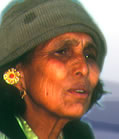 |
 |
||
 |
|||
|
GLOSSARY Nepal glossary |
transcript |
| Section 1 | "We've lost our traditional canal." I am 66 years old now. One son lives separately. Another is studying in Kathmandu. I till my land to make a living. I have about two ploughshares of dry land for maize cultivation and enough terraced land for 12-13 pathis of paddy seed. We had one community irrigation canal. This canal has now been blocked by the road construction work for the Melamchi Drinking Water Project. The community worked jointly to keep the irrigation system running. A few of us usually went to repair minor slides and clear the canal, but if the damage was major then six-seven of us would go to work. If, however, the landslide was really huge, we would depend on rainwater for cultivation and would not go to the canal. Of late, people have started cultivating winter paddy; we also do that. Water from the small rivulets is not enough and it has become difficult to farm. If we could be certain that with some effort water could be brought, all those whose land could be irrigated from the canal would gather together, clear the canal and plant winter paddy. When the canal was functional, there was enough water for our seven households to cultivate winter crops. We could plant Asaar (mid-June to mid-July) maize, and Chaitra (mid-March to mid-April) paddy. We did not need water in summer. Without the canal water, however, there is no way we can cultivate winter paddy. If the canal was running full, two-three households could irrigate their fields simultaneously. Otherwise, we had to take turns. The rotation was worked out among villagers through consensus. It was mandatory for every household to contribute labour to maintain the canal. Those who did not come to work naturally got their turn last. It needed 20-22 men when we had to determine the canal alignment, cut heavy boulders and repair the canal in some places. Without this group getting water first, there was no question of supplying the others. While making the canal, some cleared the area, some laid stone slabs and others dug up sod. With many people at work, we could complete the repair in two-three days, always motivated by the thought that the sooner we could get the water to flow along the canal, the earlier we could cultivate our land. To plant winter paddy, we had to prepare the field in Fagun (mid-February to mid-March). If we didn't plant winter paddy, then the field could be prepared by 20-22 Jyestha (mid-May to mid-June) and irrigated for a month or fifteen days before transplantation. We did not have to pay taxes or revenue; we could dig the canal on our own and irrigate fields as we wished. When enough water for one water mill was diverted to this canal, two portions of the water reached the fields. A water mill requires four portions. Half the water is lost in the canal; only half reaches the field. We used to bring water in the canal around 4th-5th Asaar, and finished paddy transplantation by the second week. Now, if it rains or we get stream water, we transplant paddy around 12th or 13th of Asaar, if we have not planted winter paddy, that is. Transplantation, otherwise, takes place in Srawan (mid-July to mid-August). From the time I remember, that is how tenant farmers made the canal. There were no drawings and no overseer. There were no measurements then, no pegs were placed and no ropes used. Once we decided that a certain elevation would ensure that water would reach the paddy field, we would build a dam. Some would engage in clearing the area, others in digging, still others in guiding the water through and some others in filling up depressions. Believe me, water would reach exactly where we intended. Building a dam, however, would take two to three days as that required piling branches of trees and bushes and pressing them down with clods of earth and boulders. We could direct the water into the irrigation channel in this manner with great difficulty, praying there was no flood, otherwise it would all disappear without a trace, bringing all our efforts to nought. And for us, that meant repeating the process all over again. We would go the next day with our implements and wooden tools and repair it. There were no overseers then, no engineer, and no Government assistance. We worked with spades and wooden levers. These days, however, we are not getting to use the canal. What happened was that the Melamchi Project was conceived to take water to Kathmandu. To make a road for that project, they covered our canal. They told us then that even if the canal were destroyed, we could still bring in water through concrete pipes. Some told us that we could still make the canal after the road was complete. And those involved in the project assured us that they would make the canal even better. I have no faith in their words, now. The old canal has disappeared, and we have no alternative. I am worried that all the paddy fields will lie barren. |